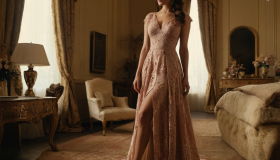As the final days of fall embrace us with their crisp air and golden hues, it’s the perfect time to reflect on the enduring connection between seasons and fashion. For centuries, the transition from summer to fall has inspired both designers and individuals, giving rise to the concept of “transitional dressing”—an art form that combines practicality with style. This seamless blend of seasonal elements has not only stood the test of time but also shaped how we express ourselves through fashion.
The Early Days of Transitional Fashion
The idea of transitional dressing first gained prominence in the early 20th century, during a time when fashion was heavily influenced by societal shifts and emerging cultural icons. The 1920s marked the beginning of this sartorial revolution, with visionaries like Coco Chanel redefining women’s wardrobes. Chanel’s designs introduced versatility and elegance, offering pieces that could adapt to both summer’s warmth and fall’s cool embrace. Her use of lighter fabrics layered with structured outerwear became a hallmark of transitional style.
By the 1930s and 1940s, designers like Elsa Schiaparelli pushed the boundaries of practicality without compromising on glamour. Hollywood, too, played a pivotal role during this period. Stars such as Katharine Hepburn and Grace Kelly became unofficial ambassadors of transitional fashion, frequently photographed in ensembles that effortlessly blended summer and fall aesthetics. Their style embodied a new wave of independence and sophistication, inspiring women to embrace their individuality.
The Evolution of Transitional Style
As fashion moved into the mid-20th century, the practicality of transitional dressing became even more pronounced. The post-war era saw a shift towards functional yet stylish clothing, reflecting a society eager to rebuild and innovate. Designers focused on creating garments that offered comfort and adaptability, paving the way for a more accessible approach to seasonal dressing.
The 1970s brought a bohemian twist to transitional fashion. This era celebrated freedom and creativity, with flowing summer dresses paired with chunky knits, ankle boots, and wide-brimmed hats. The mix-and-match aesthetic became a defining feature of transitional dressing, a trend that continues to resonate with fashion enthusiasts today.
Modern-Day Transitional Fashion
In the 21st century, the concept of transitional dressing has become more relevant than ever. With the rise of social media and fast-changing fashion trends, individuals are constantly seeking ways to maximize their wardrobes across seasons. Platforms like Instagram showcase influencers and everyday fashion lovers blending light summer staples with cozy fall layers. Think breezy maxi dresses paired with leather jackets, or delicate camisoles styled under oversized cardigans.
Sustainability has also shaped modern transitional fashion. As consumers become more conscious of their environmental footprint, the focus has shifted toward versatile, high-quality pieces that can be worn year-round. Capsule wardrobes, featuring neutral tones and timeless silhouettes, have emerged as a practical solution, allowing for effortless styling across seasons.
Key Elements of Transitional Dressing
The essence of transitional dressing lies in its adaptability. Here are some key elements to master the art of blending summer and fall styles:
- Layering:
- Combine lighter summer fabrics with warmer fall layers, such as cardigans, denim jackets, or trench coats.
- Use accessories like scarves and tights to add both warmth and texture.
- Footwear:
- Transition from sandals to ankle boots or loafers, offering both style and practicality.
- Opt for neutral or earthy tones to complement fall’s palette.
- Mix-and-Match Pieces:
- Pair flowy summer dresses with cozy sweaters or structured blazers.
- Style cropped pants with boots and a lightweight knit for a chic yet functional look.
- Accessories:
- Hats, belts, and statement jewelry can transform a summer outfit into a fall-ready ensemble.
- Use bags in rich, warm tones to tie your outfit together.
The Timeless Appeal of Transitional Fashion
What makes transitional dressing so enduring is its versatility and self-expression. It’s a style philosophy that transcends trends, allowing individuals to adapt to seasonal changes without sacrificing comfort or creativity. The practice of blending summer’s breezy charm with fall’s cozy sophistication embodies a celebration of life’s ever-changing rhythms.
Conclusion: Fashion Through the Seasons
As we bask in the last days of fall, the art of transitional dressing serves as a reminder of fashion’s ability to evolve while staying rooted in timeless principles. From Coco Chanel’s innovative designs to the bohemian spirit of the 1970s and today’s sustainable wardrobes, transitional fashion has continued to inspire creativity across generations.
Whether it’s a flowing dress paired with a chunky knit or a lightweight blouse styled with a trench coat, transitional dressing celebrates the beauty of contrasts, much like the changing seasons themselves. It’s not just a practical approach to fashion—it’s an enduring expression of individuality and the joy of adapting to life’s moments, one outfit at a time.








